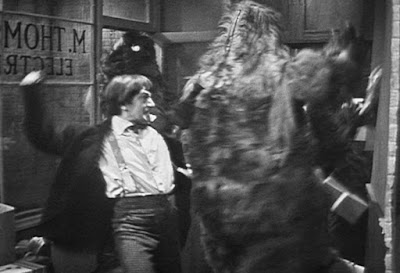Nazi Punks Fuck Off is a 1981 single by the American punk band Dead Kennedys. The song lasts only one minute and three seconds long, and yet it left an unimpeachable impression on the emerging anti-fascist organisations and unions such as Anti-Racist Action (ARA), The Anarchist Federation (AFed), as well as on the Virginian director Jeremy Saulnier.
At precisely fourteen minutes and twenty-six seconds into the 2015 film Green Room, the main characters, playing together as the aptly-named band The Ain't Rights, cover Nazi Punks to a room of... Nazi punks. This is the scene that ignites the plot of the film, unspooling the horrific events that follow it out before the viewer in an almost pre-ordained line.
This reading was brought up in an interview between Saulnier and Modern Horrors' Jason Almenas, where Almenas prompts Saulnier to discuss how this scene, and indeed the song choice, kick the film's plot into gear: 'You know it could be argued that it’s almost a jailhouse posturing like when you show a bit of aggression you get some respect, that’s what they basically did by playing Nazi Punks...' (Almenas and Saulnier, 2016) Saulnier is more than entitled to his rejection of said reading, although I do find it rich that he would so thoroughly dismiss it, seeing as his approach to filmmaking is very much built on the specific details and contexts brought with every music, clothing or casting choice. I initially read Saulnier's hand-waving as him having some small fun as the "auteur", knowing fully well that his say would typically be the last on the topic; after all, he did direct the film!
Films convey information, and the information conveyed with the choice to use Nazi Punks, beyond a sardonically humourous one, is to intimidate and raise a middle finger to the white supremacist crowd before the band. Quite literally telling the antagonists of the film to fuck off hardly fourteen minutes into the film is a bold choice to make for a narrative, and one that spurs on the main thrust of the film; being locked and held hostage within the titular green room.
Choice plays a major role in the fiction of the film, as my original review mentions quite a bit, parroting the views of critics who gave the film a surface-level reading, informing my own to be nothing more than a cobbled together, and illegible detailing of an already exhausted talking point. I chose to write the review in that way, and I'm choosing now to disregard that way of thinking here, just as Saulnier chose to disregard an interpretation of his own work. The choice in craft and the choice in narrative are dissimilar and similar things, deliberating on what choices the characters will make reflects the choice of how to block the scene they're in to effectively convey it. Green Room utilises both aspects in its own choice making, often hiding details in its foreground to connote or denote fascist imagery; text saying 'deus vult' and 'they will not replace us', Nazi and Confederate flags and most other right-libertarian tells are pasted across every inch of the Mise-en-scène. This interestingly contrasts with the iconography and Mise-en-scène that surrounds The Ain't Rights.
It'd be expected that, taken the Nazi image portrayal circling the antagonists, that the imagery surrounding our protagonists are those of anti-racism, anti-fascism and anarchy, but this isn't quite the case. The Mise-en-scène that surrounds the main characters typically depict (aside from the aforementioned fascist imagery) fairly generic punk and heavy metal symbols and texts. The Ain't Rights aren't afforded nearly as much attention for their own core values, both explicitly in the script or implicitly in the visuals. This directly ties back to Saulnier's interesting take on the igniting Nazi Punks scene, as his reading of it feels more like an "apolitical" back-tracking and finger-wagging at the more politically-conscious reviewer's own take, again contrasting with the VERY political and overtly anti-fascist nature of the song, the scene and the film itself. Saulnier's approach to this take and to the overt nature of punk/anti-fascist culture is interesting in that he appears (in the media portraying his ideals in this way) to be deliberately shutting down any left-wing perspective on a left-wing film.
Whether Jeremy Saulnier is a left-leaning centrist or a liberal simply using the language and iconography of leftist speakers and communities isn't all that important, in the end. The point of his film and the point of including a song like Nazi Punks Fuck Off is to be very obviously anti-fascist, and if that point is being made by a non-leftist, or by a group of filmmakers intent on staying "apolitical", then the end result is a far greater achievement than what they had intended, as Saulnier said himself, to do.
Bibliography:
Almenas, J. and Saulnier, J., 2016. Q&A: Director Jeremy Saulnier Talks ‘Green Room’. [online] Modern Horrors. Available at: <https://modernhorrors.com/qa-jeremy-saulnier-talks-green-room/> [Accessed 12 July 2021].
Biafra, J. (1981). Nazi Punks Fuck Off. [Single]. City: San Fransisco, CA. Available at: https://www.youtube.com/watch?v=hMlsXy3WuxM [Accessed 12 July 2021].
Green Room (2015) Directed by Jeremey Saulnier. [Blu-Ray, 5060105724015].



